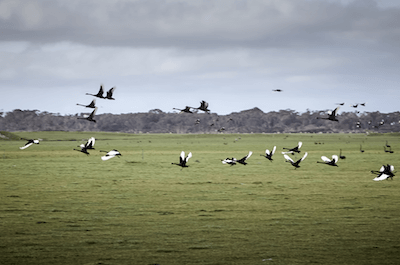My passion is sharing Flinders Island life, hosting guests, telling the stories, valuing and creating meals from Flinders Island to honour the environment, the seasons, and most importantly, my guests. The beauty of Flinders Island makes looking, breathing and walking in this pristine place on earth, so peaceful, so easy.
Staying with me at Flinders Island Gourmet Retreat at Cooma House means you are looked after, given special treats - and if you like - a practice run with Nordic Walking poles too. At breakfast all my stories are shared with you so you are prepared for the adventures of the day, especially if you’re going to observe the birdlife at the nearby bird hide or go to the Ramsar Wetland sites of Flinders Island and Cape Barren Island.
Fig 1 View from the bird hide on the Coast Road, Flinders Island. Cape Barren (Truwana) in the background.
To begin, Flinders Island is the largest island in the Furneaux group of islands in the Bass Strait, just off the north east tip of the island of Tasmania. Cape Barren Island, or Truwana, is the second. Both these islands have wetlands of significant international importance and have been declared wild life sanctuaries under the Ramsar Convention (an agreement in 1971 between countries to protect water bird habitat).
Logans Lagoon
Fig 2 Black swans leaving the ‘table’ off the east coast paddocks adjacent to the wetlands.
Fig 3 Flora across the dunes in the Ramsar wetlands
I love going to the area called Logans Lagoon on Flinders Island. It was declared a wildlife sanctuary in 1968 and adjoining land has been added over time. Logans Lagoon was designated a wetland of international importance in 1982 under the Ramsar Convention and in 1996 it was declared a Shorebird Network Site.
Fig 4 The lagoons do break out from time to time, across the far sandbar.
Logans for short, is a coastal wetland complex at the south-eastern corner of Flinders Island, about 5 km east of the village of Lady Barron. It is isolated from the sea by a large sand bar which is infrequently breached by either high water levels in the lagoon or by rough seas eroding the bar. The water in the lagoon is generally 1–2 m deep and fluctuates with rainfall, occasionally drying out. The 75 km2 catchment of the lagoon is mainly agricultural land.
Fig 5 Flora of the eastern lagoons.
Flora
The eastern side of the lagoon has a dense coastal shrubland of coast wattle and coast tea-tree interspersed with grassy patches. I love the smell of the flowers and the sea here during spring and summer and where the land is largely protected from bushfires there is a mixture of forest and scrub dominated by Smithton peppermint, tea-tree, silver banksia and Oyster Bay pine. Some manna gum occurs on dune ridges. In swampy areas there are thickets of coast paperbark. Around the lagoon margins are patches of golden speargrass, coastal tussock grassland, salt-tolerant herbs and samphire. I have a real worry though, that sea spurge is displacing all the saltbush and tussocks on the dunes. There is a mono-culture in parts and I pull out areas every time I go there.
Fauna
In winter the lagoon is an important nesting site for black swans, and watching their wings spread with white, flashing in the low sun against a grey-blue sky coloured with reflections of yellow, makes the scene other-worldly. In summer, the lagoon is a feeding and resting site for migratory waders, or shorebirds, especially double-banded plovers. Several waterfowl species use the site, including Cape Barren geese. The sound of all these birds even makes the wallaby population hold their hands over their ears!
Fig 6 Babel and Cat Islands opposite the Ramsar sites of Flinders Island
If you really want to experience a wild place, these wetlands are a must visit when you come to stay at Flinders Island Gourmet Retreat at Cooma House. We can arrange for a boating trip to take you there or or a flight where you’d land on the beach just below these lagoons.
Cape Barren Island
Cape Barren Island (indigenous name: Truwana), is part of the Furneaux Group. Australia's only native goose, the Cape Barren goose, was first documented by European explorers on Cape Barren Island.
East coast lagoons Ramsar site
On 16 November 1982, the east coast lagoons were recognised as being wetlands of international importance by being designated Ramsar site no.256. The site comprises a
4,370-hectare (10,800-acre) complex of shallow, saline lagoons among stretches of coastal dunes and beaches. Much the same as on Flinders Island, this wetland supports various plants of special botanical interest, including nationally rare species, as well as many waterbirds.
Thanks to entries on Wikipedia, I have ‘cut and pasted’ information for this post.







